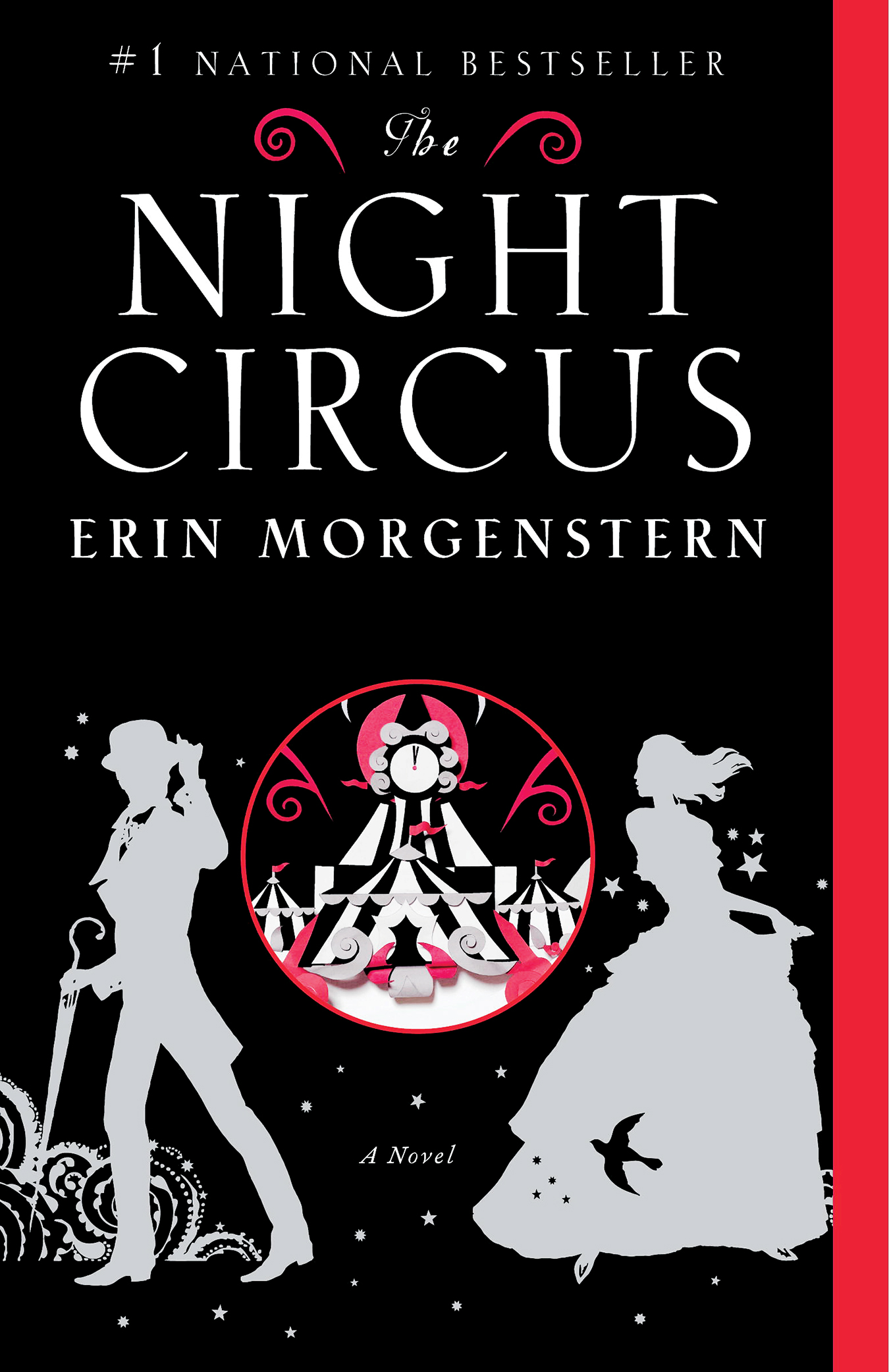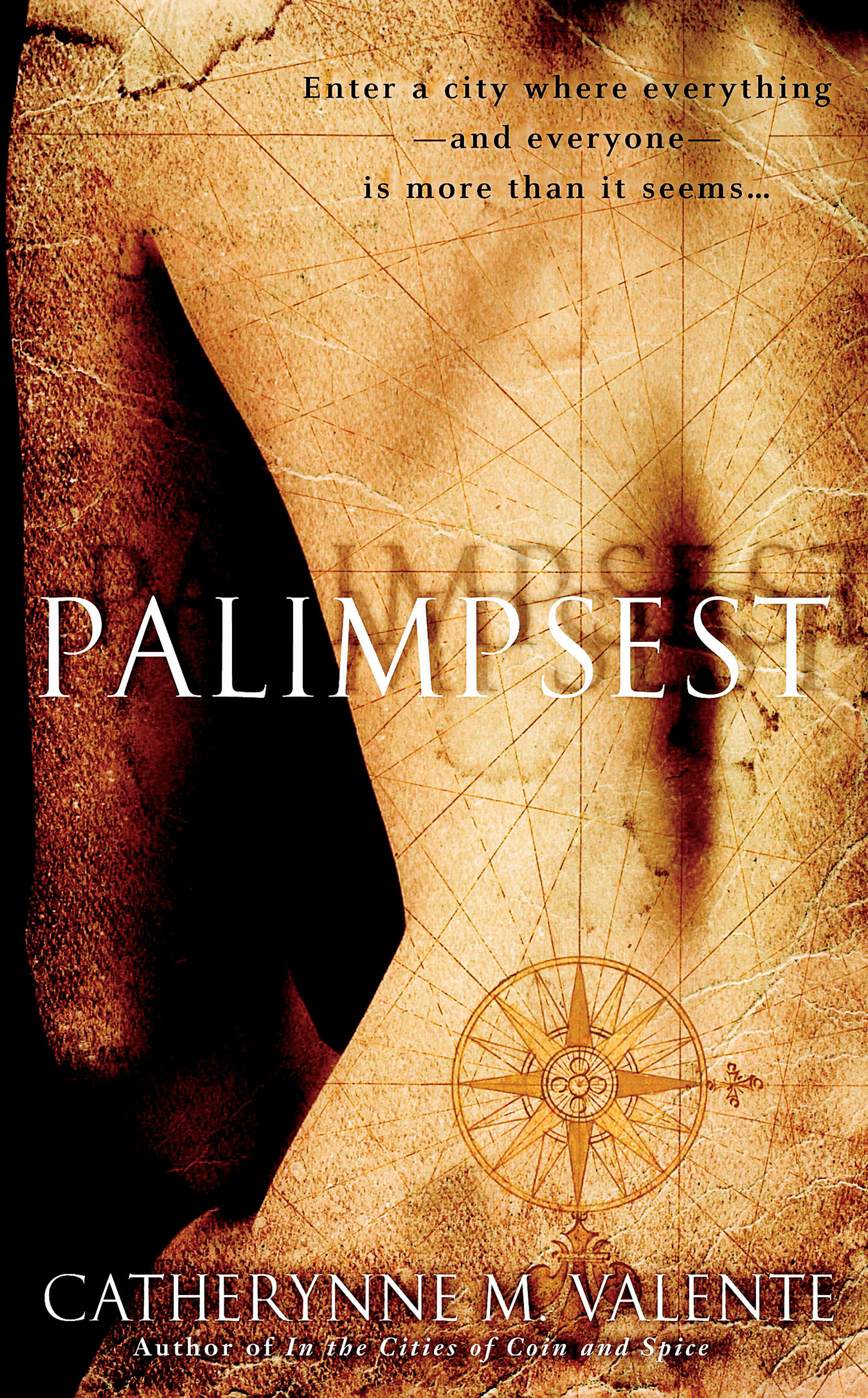-

The Night Circus by Erin Morgenstern.
-

Palimpsest by Catherynne M. Valente.
-

Angelmaker by Nick Harkaway.
Off the Shelf: Flights of Fantasy
Fiction by Erin Morgenstern, Catherynne M. Valente, and Nick Harkaway.
Few things in literature are as effective at capturing the imagination as meticulously detailed worlds. No matter whether it is a fully realized secondary world, such as J. R. R. Tolkien’s Arda, L. Frank Baum’s Oz, and even James Cameron’s Pandora, or just a version of our own (albeit with a few tweaks), such a setting can, in certain captivating instances, become as significant and memorable as any plot twist or protagonist.
The Night Circus by Erin Morgenstern
The world of The Night Circus, by Erin Morgenstern, is emotionally evocative and oddly nostalgic. The book describes the ongoing conflict between two Victorian-era magicians, conjurers of “real” magic; their strife takes the form of a sort of magical contest in which they each train a protégé from childhood to compete. The two young trainees in the current challenge are Celia and Marco, and much of the novel follows them as they grow up and develop their magical abilities. It’s a solid (if perhaps somewhat familiar) premise, but it all takes place against the backdrop of a sort of real-magic carnival, the Night Circus—and it is this incredibly depicted setting that elevates the book to a whole other level.
Descriptions of the circus are hypnotic and beautiful, somehow bringing to the fore memories and feelings of childhood excitement (even, I have discovered, in those readers who as children never visited any sort of carnival). From the very first lines (“The circus arrives without warning … It is simply there, when yesterday it was not”), it is portrayed as being a mystical, almost sentient, and quite possibly dangerous creation. Outside the closed gates, a sign warns that Trespassers Will Be Exsanguinated; when the gates open, another lists various attractions, including Flights of Fancy, Ethereal Enigmas, and Fearsome Beasts & Strange Creatures.
The story jumps across time, place, and character, with the experiences of Celia and Marco told as just two of a number that involve all manner of individuals associated with the circus. Every so often, chapters appear that describe the numerous and magnificent exhibits (which include snake charmers, a fortune teller, human statues, fire-eaters, acrobatic kittens, a maze made of clouds, a Hall of Mirrors, and many others). So remarkable is this circus that it has its own fandom of circus aficionados, appropriately called rêveurs: “They are enthusiasts, devotees. Addicts. Something about the circus stirs their souls, and they ache for it when it is absent.”
It is impressive how Morgenstern manages to evoke this feeling of wonder in the reader as well. Part of this is through the use of a few characters who become rightfully fascinated—just like the reader—by the circus. One of these is Bailey, who is a young boy when the circus first visits and is properly stricken after visiting: “Everything was magical … He could not properly describe it afterward. He could only nod when his mother asked if he had enjoyed himself.” Bailey as a surrogate for the reader is a critical element of the story; years later, when a teenaged Bailey notices that the circus has returned, it is for us, through him, an unexpectedly emotional moment.
I have eschewed much in the way of a detailed plot description, not for any deficiency on that level but simply because the setting is so wondrous, so vividly dream-like (yes, paradoxically so), that it tends to overshadow all other elements. The nature of the ages-old conflict between the two conjurers is sometimes vague (both for its participants—Celia and Marco—and for us), but we readers are not unlike the circus patrons: perhaps not always cognizant of what is going on, but so delightfully distracted by the magnificent sights that it is of no real concern.
Palimpsest by Catherynne M. Valente
The world of Palimpsest, by Catherynne M. Valente, is dark and not easily forgotten. The story follows four characters from the “real” world who explore the astounding city of Palimpsest, a city not of our world but entered through our dreams. It has a rather bewitching effect on people, and the exquisitely written depictions make it easy for the reader to see why.
In the city is Zarzaparrilla Street, which is “paved with old coats. Layer after layer of fine corduroy and felt and wool the colors of coffee and ink. Those having business here must navigate with pole and gondola, ever so gently thrusting aside the sleeves and lapels and weedy ties … Great curving pairs of scissors are provided in case of sudden disaster, tucked neatly beneath the pilot’s seat.”
There are houses that may in fact be living creatures; one such abode, “well-fed beyond all dreams of cornice and window hinge, began to grow so quickly and with such vigor that the houses on either side of it were forced to pick up their prodigious suitcases and, with much pointed sniffing, homestead elsewhere.”
There is a transportation system that is actually a network of sentient locomotives; they are so animal-like that “in days of old, great safaris were held to catch the great trains in their inexorable passage from place to place, and women grappled with them with hooks and tridents in order to arrive punctually at a desk in the depths of the city.”
Certainly the descriptions are singular, but the hook of the novel lies in the rules that govern travel to the city from our world, for to journey to Palimpsest requires not a wardrobe, nor a pair of ruby slippers, nor a golden compass. No, in a brilliantly subversive twist on fairy tales, entrance to Palimpsest is granted through having sex with other individuals who have already been there.
Valente takes the time to explore all the repercussions of this device; for example, those who have been to the mesmerizing city generally become obsessed with returning, which leads to a sort of underground subculture of sex clubs where those wanting nothing more than passage can meet. One character remarks, “No one dances anymore. It’s a waste of time. We’ve cut it all down to the barest necessary interactions”; the experience is “usually ugly, and fat, and sweaty, and lonely. Luckily, it’s also usually quick. But afterwards … we find a place where we belong.”
It’s a fairly brilliant notion, really, making the action of entering a fantasy land akin to a type of addiction or disease. (“Some people drink themselves out of school trying to find it again, trolling through bars where the shadows are so greasy they leave trails on the walls, just to find a way in, a way through. Some people forget too that you’re supposed to stop sleeping, you’re supposed to have a life in the sun.”) In addition, those who have made the journey return branded with a sort of birthmark or tattoo that depicts a map of a particular section of the city; it is implied that you can only travel to the location with which your immediate partner is marked, resulting in a sort of carnal scavenger hunt for those wanting to explore the city in its entirety.
The narrative ebbs and flows, gently pushed by tense changes between chapters that alternate between those scenes set in Palimpsest and those set in the waking world. It is all fantastically dense, or perhaps densely fantastical; Palimpsest is a work of beautiful language rivalled only by the astonishing city it describes.
Angelmaker by Nick Harkaway
The world of Angelmaker, by Nick Harkaway, is an amusing amalgam. The mix of genres includes elements of fantasy, but also of science fiction, spy, and steampunk—all described via Harkaway’s uniquely quirky style of writing.
Chiefly set in London, it tells the story of Joshua Joseph Spork, who runs a shop on the banks of the Thames repairing, selling, and dabbling in clocks and clockwork devices. He lives in the shadow of his deceased father, Mathew, who was a criminal mastermind; Joe is determined to preclude a similar existence, and thus strives to avoid in all respects anything remotely connected to illegality. (“It is the chosen path of Mathew’s son: be quiet, be compliant, let the world slip over you and around you unnoticed. Bend with the wind. Because the tall tree gets hit by lightning and the high corn breaks in a gale.”) He lives a life of more-or-less mundanity, with the only conflict coming from an ongoing battle with the local cat. This is, he readily admits, a fairly dull existence; “he tries not to reflect on the nature of a life whose high point is an adversarial relationship with an entity possessing the same approximate reasoning and emotional alertness as a milk bottle.”
But things are about to change quickly and early for our stalwart Joe. Soon he is embroiled in a conspiracy that involves a mysterious book, a serial killer, clockwork bees, killer monks, and the adventures of a now-90-year-old secret agent, Edie Banister, whose career is told in appropriately Ian Fleming–esque flashbacks. The McGuffin of the story: “a weapon so awful that the world cannot survive its use, so that no one would use it save in the moment of their own inevitable destruction, and no one seek or allow the destruction of the one whose hand is on the hilt, lest they find the blade cuts every throat on Earth.”
It might all sound excessive, bombastic even, and it might indeed be so were it not for Harkaway’s writing. His not-quite-meandering method takes a chapter or two of getting used to, but not much more, for it is charming and entertaining and it exhibits a sort of perfect literary comic timing. The book is rife with anecdotes and asides, Harkaway’s paragraphs being miasmas of factoids and flashbacks that periodically amble away from the main plot to examine a prodigious variety of topics ranging from the business of undertakers to the subtleties of running a game of three-card monte. Through Harkaway’s eyes, the various genres and their associated tropes—from Edie Banister’s undercover missions to the almost noirish descriptions of the London criminal underworld—are not only vividly deployed but also entertainingly blended. And despite the humour and sometimes manic style, each chapter is admirable in its ability to place the reader in its immediacy; it is in many places masterfully tense.
These three creations—the emotional entertainments of The Night Circus, the haunting dreamland of Palimpsest, the genre-splicing setting of Angelmaker—are each in their own way masterful in their ability to draw us into their worlds. When the most unenjoyable aspect of a book is having finished it and left the extraordinary environs, it is a sweet goodbye to such places indeed.




